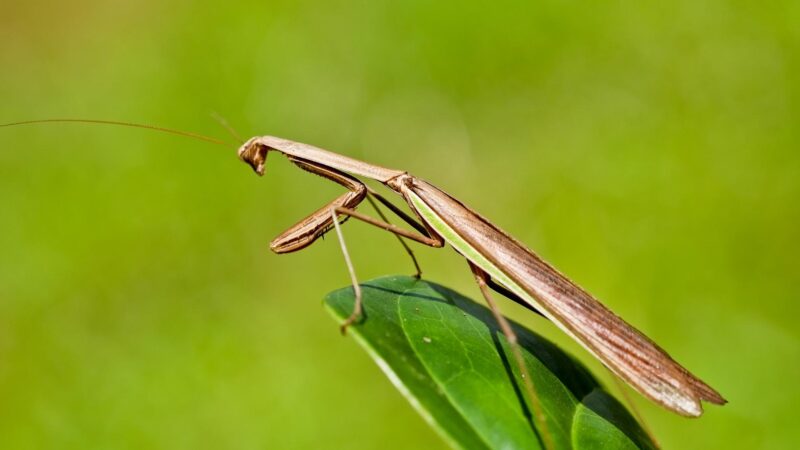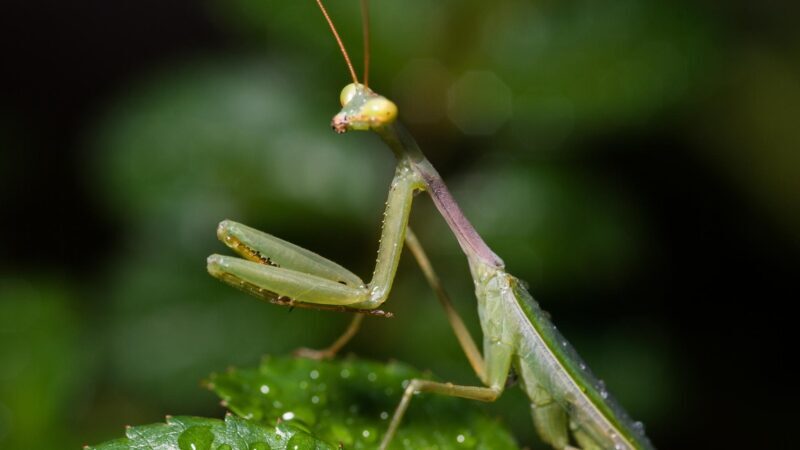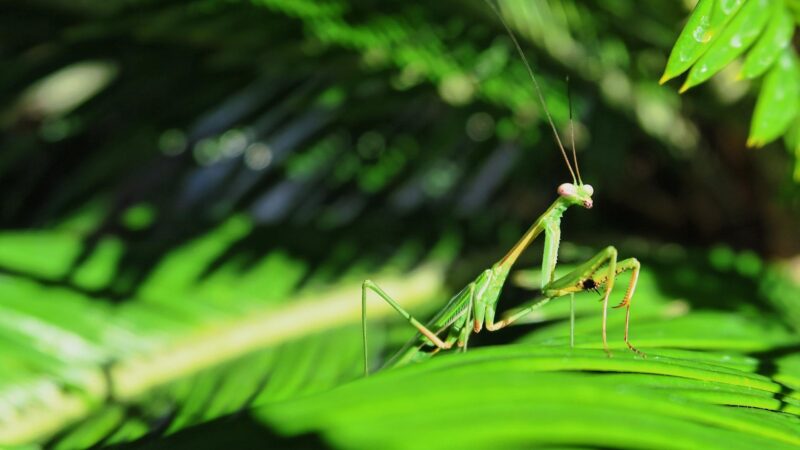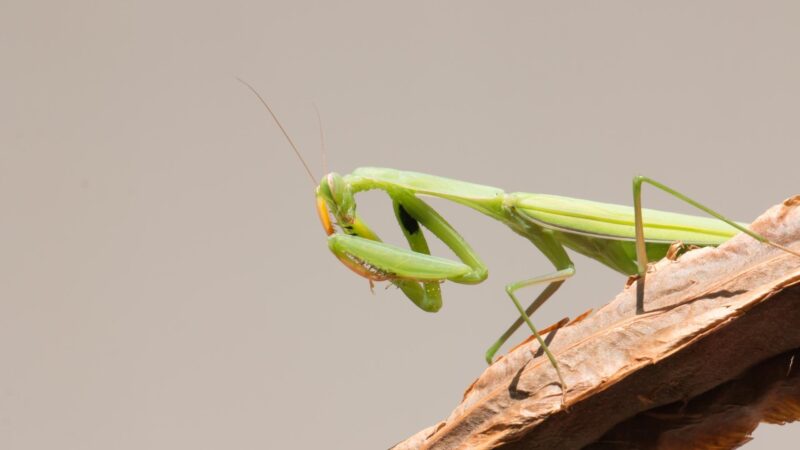Praying mantises are great predators in the insect world because of their physical attributes and their incredible speed. And although they look similar to grasshoppers and crickets, they are more closely part of termites and cockroaches.
Praying mantis are not dangerous to humans. Praying mantis are predatory insects that prey on other insects, such as ants, wasps, and bees. While they can bite, they are not harmful to humans and pose no threat to humans.
Table of Contents
Praying Mantis Identification

Scientific Name
Praying mantises are also known as Mantis religiosa in scientific terms.
Appearance
It has a body that is brown and black with white markings on the thorax, abdomen, and legs. Their eyes are large and black, with mandibles that are long and thin. Their legs are long and thin, with claws on the forelegs. It has bright orange wings that extend from its abdomen when it flies.
Color
Praying mantises are mostly colored green and brown. It has been suggested that the color patterns of praying mantises are related to the amount of light they receive, with darker colors indicating higher levels of light.
Lifespan
Praying mantis usually has a minimum lifespan of 1 month depending on the quality of food they eat.
Habitat
Most of them are usually found in dry areas near bodies of water or trees where they can find prey.
Length
Female mantises usually grow to a maximum length of 0.75 inches, while males grow to 1 inch or less; both sexes have wingspans of 1-1.5 inches. As with all mantises, or mantids, as they are also known, the female is larger than the male, particularly in the abdomen.
Wingspan
The wingspan of a praying mantis is 1 to 2 inches. Small size allows them to be able to fly with ease. This is because they can flap their wings in an instant, and they can run fast enough that they can catch a meal before it escapes from your hand.
Weight
The weight of a male praying mantis is typically between 17 and 25 milligrams, and the weight of a female is typically between 14 and 20 milligrams.
Diet
The diet of praying mantis is largely composed of insects, and they will eat anything that fits in their mouths. Praying mantis eat a variety of insects, including bees, bugs, spiders, beetles, and grasshoppers. They also eat some small vertebrate animals like mice or small lizards. They can also eat other arthropods like scorpions and centipedes if they find them first.
Place of Origin
The praying mantis is native to Mexico, Central America, and the Caribbean, while other species can be found in tropical regions of the Americas. Primarily, however, the praying mantis can be found in many environments, including forests, grasslands, and deserts.
They live in areas that have high humidity levels and temperatures around 77°F (25°C). Praying mantises spend most of their time at night when they hunt for food or shelter.
Characteristics
Praying mantis are characterized by their strong mandibles and the ability to spin silk. They have a long, pointed snout and large eyes, which give them excellent vision. The wings of a praying mantis are tiny—they are used for flight only when necessary.
Praying mantises also have powerful jaws with which to capture their prey. Their bodies are covered in sharp hairs that help them grasp their prey and protect them from predators.
What to Do if You Find a Praying Mantis?
Mantises are not venomous and won’t attack unless you threaten them. They are gentle creatures and shouldn’t be harmed unnecessarily.
If you find one in an urban area near an open window or door, take note of its location so that you can report this to your local wildlife biologist or pest control company. This will help to keep praying mantis populations under control!
Is it safe to hold a praying mantis?

When you hold a praying mantis, you’re not likely to get any venom from its fangs unless you have an allergy or have been bitten before by the same kind of praying mantis. But even if you do get bitten, your chances of getting sick from it are pretty low—unless you have an allergy or have already been bitten before by the same kind of praying mantis.
The worst action you can take is to grip the insect wildly. The praying mantis is likely to believe it is being attacked and may bite.
How Do You Pick Up a Praying Mantis?
You can put your palm in front of a praying mantis if you see one wandering around in your garden. The mantis should ideally approach your palm casually and without ever feeling threatened.
For optimal results, place a flat hand with the palm up right in front of the praying mantis. Avoid moving too hastily to avoid startling the mantis.
Will Praying Mantis Attack Humans?

Praying mantises can attack people when they feel threatened (such as being picked up or stepped on), but this is rare and only occurs in extreme cases.
The most common way that people get bitten by praying mantises is when they accidentally step on them while walking through grass or brush at night.
What Happens if a Praying Mantis Bites You?
While praying mantis aren’t naturally venomous, you may see noticeable red or swollen marks if it bites you. The mantis’s teeth are like tiny needles, and they’re used to pierce the skin of its prey. But they don’t bite hard enough to puncture the skin—instead, they inject venom through the tips of their teeth.
The venom will cause swelling and tenderness around the wound, but it won’t hurt much at all, otherwise. That means if a praying mantis bites you there’s no need to worry about swelling or pain (though we do recommend calling your doctor if you feel feverish).
The only way to tell if a praying mantis has bitten you is by looking for small red marks where its needle-like teeth punctured your skin.
Should I Leave a Praying Mantis Alone?

If you find yourself in an area where there aren’t many other insects around, you might want to leave the praying mantis alone. In other cases, contact your neighborhood wildlife biologist or pest control business if you have discovered a large number of them.
Is Praying Mantis Good for Your Garden?
Praying mantis are ferocious and dangerous predators, yet they are not entirely helpful insects. They are, if anything, a neutral element in the garden because they are equally likely to devour a butterfly or bumblebee as they are unfriendly caterpillars.
Even if they are released in the garden, they will not likely become abundant in the environment because they feed on one another. They may not have much of an impact on a specific insect problem because you cannot rely on them to stay where you want them to.
What Kills a Praying Mantis?
The mantis has many predators, but the biggest threat to their survival is dehydration. The mantis needs water to survive and drink to stay hydrated, so if they do not get enough water, they will die within a couple of days. Other predators that impose harm to praying mantis are frogs, birds, spiders, and large hornets.
Frequently Asked Questions
Are Snakes Afraid of Mantis?
Even though they aren’t the praying mantis’ favorite meal, snakes are something they frequently interact in combat with. Mantises are fierce, persistent hunters, and they will never pass up the chance to feast on an animal like this.
Furthermore, they are experts at camouflage. Young snakes that are moving among the plants are typically eaten by praying mantises.
Can a Praying Mantis Cut Your Finger Off?
A praying mantis cannot cut your finger off. That’s just an urban legend. The praying mantis cannot cut off human fingers, nor can it even break them, as some people have claimed. In fact, the only thing they are good for is eating insects.
Praying mantises cannot tear or cut off human flesh with their mouths. This is because its forelegs are not strong enough to do so. It can only pierce the skin with its hypodermic needle-like stinger, which is not strong enough to penetrate through human flesh.
Why Do Praying Mantis Stay In One Spot for Days?
When praying mantises are in the process of mating, they will stay in one spot for a very long time. The reason for this is to make sure that he or she chooses the correct mate.
Additionally, praying mantises to tend to stay in one spot for days at a time because not only do they need shelter from predators like spiders and birds but also because they need enough space for themselves plus all of their food sources if needed.
All things considered, praying mantises are pretty harmless. They tend to go after smaller insects; they don’t eat vegetation nor do they bite humans unless you accidentally step on one.
List of Sources
Should I Release Praying Mantis into My Garden? (2021). University of New Hampshire.
Crumley, K. (2018). Praying mantis. Texas A&M University System.
Praying Mantis. (2021). Iowa State University.
Watkins, G., Bessin, R. (2019). Praying Mantids. University of Kentucky.
